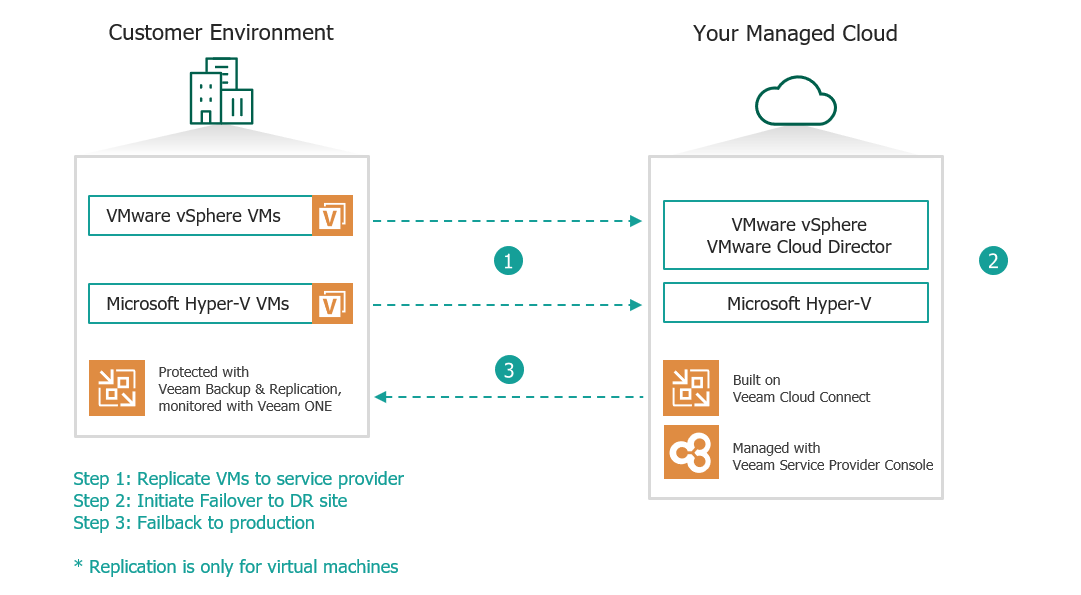Disaster Recovery as-a-Service (DRaaS)
Service description
A Service Provider can build a Veeam-powered service to provide Disaster Recovery as-a-Service (DRaaS) to his customers allowing them to focus 100% on their business. The customer no longer has to think about building a DR site and everything that comes with it (servers, connectivity, power, networking, software, licenses and more). The Service Provider can leverage the existing hosting infrastructure (IaaS) or may build a new and dedicated infrastructure for the service. Resources (such as CPU, Memory, Storage and Networking) can be offered as shared, (partially) reserved or dedicated to customers.
Thanks to the support for multi-tenancy of Veeam Cloud Connect and the integration into Veeam Backup & Replication, customers can be easily onboarded in no-time. When disaster strikes, the customer can use a web-based portal to initiate a full site failover or contact the Service Provider to put the DR plan into action.
Additionally the service can include, but is not limited to:
- Replication of VMware vSphere VMs at the customer into VMware vSphere at the service provider.
- Replication of VMware vSphere VMs at the customer into VMware Cloud Director (VCD) at the service provider.
- Replication of Microsoft Hyper-V VMs at the customer into Microsoft Hyper-V at the service provider.
- The customer can choose to use the service provider only as a DR target, thus taking responsibility of configuring replication jobs and defining RPO. The service provider is only responsible for the availability and uptime of the DR target itself.
- The customer can choose to have the service provider manage also the on-premises installation. The service provider is responsible for configuring replication jobs, defining RPO and provides an SLA to the customer for each part of the service.
- Create an effective Business Continuity and DR Plan. Once created, the most important part is to keep it as up-to-date as possible and test regularly.
- Frequent failover and failback tests. To guarantee proper delivery of the service, the service provider can schedule frequent testing in cooperation with the customer.
High-level diagram

Value proposition
Service Provider main benefits:
- No upfront costs. Pay only for the licenses consumed by the customer.
- Leverage IaaS investment. Next to providing IaaS to customers, also offer DR services on the same platform.
- Expand services. Start with offering only a DR site target. Expand into Off-site Backup, fully managed MSP and other services.
- Automation. Fully manage and automate the solution via PowerShell or RESTful API.
Customer main benefits:
- Business focus. Focus 100% on business needs and let the service provider take care of the rest.
- DR expertise. DR is much more than just “copying” some machines off-site. The service provider handles the infrastructure, documentation, testing, failover and failback. In return the customer receives an SLA that identifies both the services required and the expected level of service from the service provider.
- Self-service failover. The customer can initiate the DR plan via a web-based console.
Veeam Solutions
The service is built with the help of the following Veeam solutions:
| Service Provider side | Customer side |
|---|---|
| Veeam Service Provider Console (VSPC) | Veeam Backup & Replication (VBR) |
| Veeam Cloud Connect (VCC) | |
| Veeam Disaster Recovery Orchestrator (VDRO) |
Licensing and pricing
Veeam offers the following:
- Pay-as-you-grow pricing plans that offer consumption-based licensing
- Automatic license update capabilities to maintain license distribution
- Purpose-built products and partner portals to facilitate monthly usage reporting
Please check our Veeam Rental Licensing and Usage Reporting Reference Guide for more details.
Service Providers can charge for the Veeam-powered service in different manners. Options can include, but are not limited to:
- Per machine protected, optionally including:
- storage
- management
- support
- monitoring
- reporting
- Storage consumed (e.g. per GB/TB)
- Separately per machine protected and storage consumed
- Fixed fee for the entire environment
- Per recovery test (e.g. every quarter)
-
Creation/Update/Test of the Business Continuity and DR plan
- When leveraging VCD, allocation models allow for even more flexibility:
- Allocation Pool: Lowers the price for the customer as only a percentage of the allocated resources is committed (guaranteed).
- Pay-As-You-Go: Customer only pays for what is consumed at the time of DR. No guarantee enough resources will be available at that time.
- Reservation Pool: Increases the price for the customer as all resources are 100% committed and are not shared with other customers on the platform.
- Flex Allocation Model: In essence a Pay-As-You-Go-like model along with VM granular control.
Want to know more?
Enroll in our free online VMSP / VMTSP Cloud Service Provider training course to learn more about the DRaaS use case.
